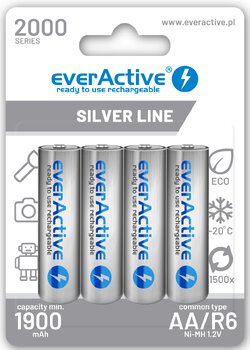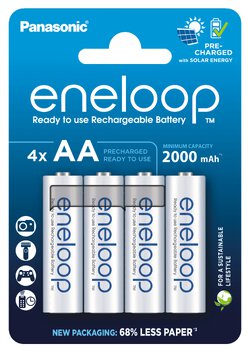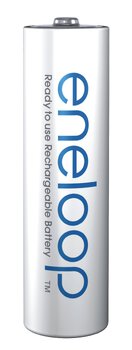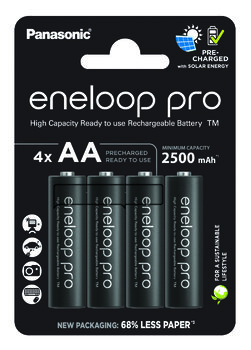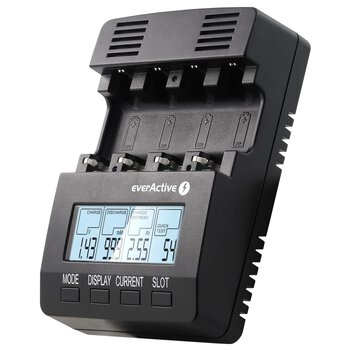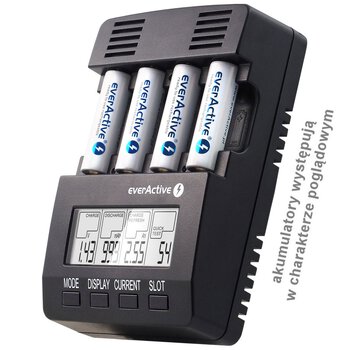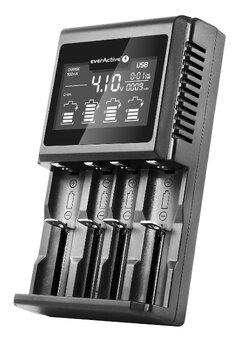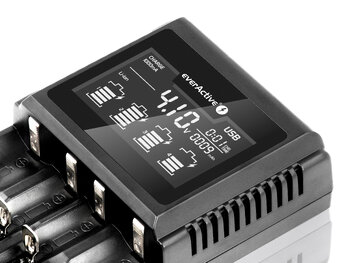- Tips
- technology
- Frequently Asked Questions
- Tests
- mAh capacity
- Rated Capacity
- everActive
- comparison
- Durability of rechargeable batteries
- Efficiency of rechargeable batteries
- battery voltage
- Accumulated energy
- Batteries vs rechargeable batteries
- LR03 AAA
- LR6 AA
- eneloop
- AG13 LR1154 LR44
- Delta V
- Charge Cycles
- internal resistance
- charge level
- CR 2032
- memory effect
- accredited test
- SR44 357
- Hearing Batteries 675
- SR626 377
- Watch Batteries
- Polarity
- Mah
- passivation
- LS 14250
- LS 14500
Facts and myths about charging Ni-MH batteries. Advice for users of Ni-MH rechargeable batteries. Frequently asked questions and problems.

We will try to keep this article updated with relevant information.
People who have been using nickel-metal-hydride Ni-MH batteries for years have certainly experienced unusual observations at least a few times.
Below we describe the ones that cause the most problems.
Table of contents:
After use and insertion into the charger, the battery does not want to charge - the charger does not detect it.
My device does not work or works for a very short time on Ni-MH batteries.
Ni-MH AA R6 rechargeable batteries are not compatible with disposable batteries - they have different dimensions, they are too thick.
The charger detects rechargeable batteries but ends charging much prematurely, the batteries do not heat up during charging, they remain discharged.
The charger measures zero or very low mAh capacity in discharge or capacity test mode.
My batteries are not optimally charged, they heat up a lot. Isn't slow charging more suitable for my rechargeable batteries?
Is it worth discharging Ni-MH batteries completely before they are charged in the charger?
1. The battery does not want to charge after use and insertion into the charger - the charger does not detect it
MYTH - the battery has been damaged and cannot be charged.
FACT - the battery has been discharged too deeply - although it is subject to partial, permanent degradation, in the vast majority of cases it can be successfully restored to operation.
Rechargeable batteries in our devices are usually connected in series of 2, 3, 4 pcs, etc. Currently, a very popular device that fits into this scenario are the increasingly common trail cameras, where we install a large number of rechargeable batteries at a time. Although a similar problem can apply to almost any other device, where we install a minimum of 2 pcs. or more rechargeable batteries - this type of problems can be observed in computer mice, keyboards, flashlights, etc. etc. We are convinced that every experienced user of Ni-MH rechargeable batteries has encountered this problem at least once.
When the entire pack is completely discharged, a single cell, which had even a slightly lower capacity than the others, is very likely to be discharged too deeply - to 0V (and may even be reversed, which is extremely harmful).
This is because Ni-MH batteries efficiently release current until the very end until they are completely discharged. The safe voltage limit of 0.9-1.0V can be quite easily exceeded when they work in a pack of 2, 3, 4+ pcs. Unfortunately, such a deeply discharged battery is permanently degraded, and in addition, the vast majority of advanced chargers will have problems detecting and charging them.
A good charger has numerous protections, m.in. against short circuits, reverse polarity, etc. A battery discharged to 0V is nothing more than a piece of foreign metal in such a charger. In order for any safety mechanisms in the charger to have a chance to work, the battery should have at least a minimum voltage.
If we allow the battery to discharge so deeply that the charger does not detect it, the easiest method is to borrow energy from another, at least partially charged battery. All you need to do is connect the batteries with a short cable according to the diagram (plus to plus, minus to minus) for about 5-10 seconds, and then immediately place our "zero" battery in the charger - it should be easily detected by the charger. As we mentioned, too deep discharge is very harmful to any Ni-MH battery, so do not delay recharging such cells - the longer it remains discharged, the lower the chances of its subsequent effective resuscitation. Here is an important tip - unused batteries should be stored partially charged (preferably in about 50-60%) and temporarily control the level of charge / control the voltage values - a voltage drop of the stored battery below 1.20V means that it needs to be recharged.

Such a discharged, resuscitated battery can unfortunately still cause problems during charging - it often happens that the charger disconnects the charging very quickly (due to a very fast, rapid increase in voltage), not allowing it to be fully charged. Then we have no choice but to resume the charging process until it is successful. Another problem is prolonged charging - then the risk of overcharging such a battery increases. When charging such a deeply discharged battery, it is good to be extra careful and keep an eye on the typical charging time of a given battery in our charger.
In order to minimize the risk of such deep discharge of batteries (the phenomenon cannot be completely eliminated), it is important to use batteries that are as equal as possible, from the same batch, with the same capacity.
If you have bought new batteries that have not been used yet - recharge them, even if they are new generation pre-charged batteries with a low self-discharge rate. This will give us confidence that at the time of installation in the device, all batteries will be as equal as possible, with exactly the same degree of charge.
The same applies to rechargeable batteries that have been waiting in a drawer for several months "for their turn" - it is worth recharging such batteries immediately before use - this will minimize possible later problems.
Remember - if you decide to buy rechargeable batteries, you should try to use them regularly. Rechargeable batteries that lie for months in a drawer or unused equipment also age quite quickly - with the highest capacity batteries degrading the fastest.
2. My device does not work or works for a very short time on Ni-MH batteries
MYTH - Ni-MH rechargeable batteries always work worse than alkaline batteries because they have a lower voltage of 1.2V vs 1.5V.
FACT - in many applications, Ni-MH rechargeable batteries achieve a higher operating voltage than alkaline batteries. The value of 1.2V is the average value of the battery duty cycle, while 1.5V is the start (output) voltage of the alkaline battery at the beginning of the duty cycle.
We encourage you to read another post, where we compare the parameters of 1.2V Ni-MH batteries and 1.5V alkaline batteries in more detail, and explain why the advantage of higher voltage in alkaline batteries is often apparent.
Situations when the device does not start at all on fresh batteries are usually limited to three reasons - either the batteries are not properly charged, sufficiently charged, are very heavily used (they have a very high internal resistance) or simply do not make contact in the power compartment of the device. The whole topic, however, requires a more extensive commentary - we invite you to read our article: "Why do fresh Ni-MH rechargeable batteries still not work in my device or work much worse than disposable batteries?"
3. Ni-MH AA R6 rechargeable batteries are not compatible with disposable batteries - they have different dimensions, they are too thick
MYTH - The larger diameter of Ni-MH batteries does not allow them to be used - they do not fit in the power compartment of the device.
FACT - The acceptable dimensions described by the standards for rechargeable and disposable AA R6 batteries are exactly the same - the standard says about a diameter of 14.5 mm.
There is a common belief that rechargeable batteries are thicker than alkaline/disposable batteries, which makes them impossible to use in many devices. However, harmonization standards leave no illusions - the IEC/PN-EN standard, which specifies the maximum sizes of AA R6 LR6 cells, etc., assumes a maximum thickness of 14.5 mm.
The usability problem arises from the fact that not all devices (some flashlights, toys, etc.) allow the thickest cells to be placed.
Capacious R6/AA Ni-MH batteries available on the market are usually about 14.2-14.4 mm thick, while most alkaline batteries are in the range of 14.0-14.2 mm. In extreme cases, the differences in diameter between the cells can be more than 0.5 mm.
In fact, the culprit of this incompatibility is the manufacturer of the device, who has introduced a product with a poorly sized power compartment for the size of an R6/AA battery. In this case, the only solution may be to find and use rechargeable batteries with a diameter as close to 14.0mm as possible.

In such cases, we recommend everActive R6/AA Silver Line batteries, which have a typical thickness of only 14.0 mm - thanks to this, they are dimensionally compatible with most alkaline batteries and guarantee maximum compatibility in any device.
The diameter of 14.2-14.4mm is typical for almost all Ni-MH R6/AA batteries with a capacity of over 1800 mAh that can be found on the market, regardless of the manufacturer, only with very few deviations "downwards" and only in the case of batteries with a capacity not higher than 2000 mAh.
A well-designed device should theoretically accept any battery that complies with the standard without any problems. However, there are devices where we can push the cell to about 14.0 mm in diameter - but then it is either a deliberate effort of the manufacturer to make the device work only with specific/selected brands/types of cells, a simple oversight of the designer or a completely conscious choice. In the latter case, the battery compartment is constructed in such a way that if the installation of 14.5 mm cells is allowed, then the 14.0mm or slightly thinner ones would simply be too loose - then we are dealing with one or another compromise, but directly on the side of the target device, not the battery itself (the dimensions of which are quite precisely determined by the relevant norms or standards).
4. The charger detects rechargeable batteries but ends charging much prematurely, the batteries do not heat up during charging, they remain discharged
MYTH - this indicates damage to the charger or rechargeable batteries.
FACT - this is a fairly typical observation in the case of batteries that have been deeply discharged, or those that are used irregularly or rarely recharged. Sometimes it means a problem with heavily worn batteries with very high internal resistance.
There are several reasons for this behavior.
Most often it applies to deeply discharged or heavily dependent batteries, where immediately after installation in the charger there is a rapid increase in voltage and then a decrease - such behavior for many chargers is synonymous with achieving a full charge and thus the battery "cheats" the charger, which signals to us that it is fully charged. If you have any doubts in this regard, wait about 30 minutes and repeat the charging process. If it does not run out within the next 10-20 minutes, it is very certain that our battery has not been fully charged beforehand.
A similar situation can occur in the case of heavily worn batteries with very high internal resistance. The safety mechanism of advanced chargers usually interrupts the charging process after a few seconds or the first minutes after detecting such an anomaly (often showing a full battery symbol). Resuming charging, even many times, will not change anything, because each time charging will be completed quickly. Batteries with very high internal resistance should not be used for safety reasons.
5. The charger measures zero or very low mAh capacity in discharge mode, or capacity test
MYTH - the charger measures incorrectly, because the batteries still work for weeks in my clock, remote control, etc.
FACT - usually such a battery has a very low or zero usable capacity and is very heavily exploited.
Popular chargers have variously implemented ways of measuring the capacity of rechargeable batteries during discharge. In the most usable test, a specific load is applied to the battery, and the measurement ends when the voltage measured under load drops to 0.9V/1.0V on such a cell. In the case of a battery with very high internal resistance, it may happen that the voltage will immediately drop by 0.3-0.4V within the first seconds - this is enough to assess such a battery as useless with zero capacity.
Even if such a battery still works in simple devices, we strongly recommend its disposal.
6. My rechargeable batteries are not optimally charged, they heat up a lot. Isn't slow charging more suitable for my rechargeable batteries?
MYTH - use the lowest possible charging current - this extends the life of the batteries, and the batteries do not heat up.
FACT - the charging current must be correctly selected depending on the batteries and charger you have. In advanced automatic chargers, the current should not be set too low, as this may prevent the charger from detecting full charge and consequently lead to overcharging of the battery.
At the beginning, it is worth reading our other article "Does fast charging harm Ni-MH batteries? How to properly charge nickel-metal-hydride batteries?".
The fact that Ni-MH batteries heat up at the end of the charging process is something completely natural and indicates a correct - full charge.
However, a protracted charging process with very hot batteries can be harmful and may indicate an anomaly. In particular, batteries that are recharged very irregularly (used in devices with very low power consumption) or dependent, unused for a long time often cause this type of problem during charging.
Even when a sufficiently high charging current is selected, the batteries do not reach sufficiently high voltage levels, which can cause problems even with advanced automatic chargers. If you have any doubts in this regard, stop the charging process manually, wait for the batteries to cool down, and then repeat the charging process - if it is completed within 10-20 minutes, it will mean that the batteries have been properly charged. Otherwise, when charging continues and the batteries heat up very much again, it may mean a more serious technical problem with our Ni-MH batteries.
7. Is it worth discharging Ni-MH batteries completely before they are charged in the charger?
MYTH - definitely yes, discharging the batteries before each charge guarantees that the maximum capacity is maintained for many years of operation.
FACT - Ni-MH batteries are definitely not recommended to be "forced" discharged before each charge. In typical "half" discharge cycles, the useful capacity on the batteries decreases about 4 times slower than in the case of full discharge and charge cycles. This can provide us with up to 100% more usable energy to use over the life of the battery.
We also discuss this topic in another article "Is it worth discharging Ni-MH batteries before each charge?"
The theses about the need to discharge a nickel battery each time have their source in Ni-Cd batteries, which were heavily affected by the so-called memory effect ("What is the memory effect and does it apply to Ni-MH batteries?"). In the case of Ni-MH batteries, it is better to avoid discharging the batteries completely too often.
Panasonic's internal tests on Eneloop batteries clearly show that batteries that are regularly only half discharged can withstand up to 4 times as many charge cycles as those that are completely discharged to 1.0V each time. Similar conclusions can also be drawn from the documentation of other manufacturers as well as from the analysis of technical requirements for Ni-MH batteries according to IEC / PN-EN standards.
In everyday use, when using popular chargers, we can encounter other problems. Chargers have a very different way of discharging the batteries. Most of them discharge the batteries to a level even lower than the mentioned 1.0V, and in addition, it happens that the voltage measurement is not made under load - as a result, in some chargers we can unconsciously discharge our batteries below the safe level of 0.9-1.0V (even 0.6V as in the attached graph), and this will lead to their depletion even faster.
A properly implemented discharge mode is very useful for diagnostic purposes, tracking down possible problems with the battery, or for tracking the wear of the batteries, but we absolutely should not use it before each charge of the Ni-MH battery.

See popular rechargeable batteries and chargers in the hurt.com.pl store
New - improved MCDE series Higher capacity min. 2000 mAh - up to 2100 charging cycles New improved HCDE series New eco-friendly packaging for storing rechargeable batteries - the highest capacity among the new generation of 2500 mAh rechargeable batteries
4x everActive R6/AA Ni-MH 2000 mAh ready to use "Silver line"
4 x Panasonic Eneloop Ni-MH 2000mAh BK-3MCDE/4BE rechargeable batteries (blister)
New eco-friendly packaging for storing rechargeable batteries
- retains 70% of energy after 10 years after charging!
- works at low temperatures down to -20°C. C!
- charged in the production process with solar energy
Made in Japan
4 x Panasonic Eneloop PRO NEW Ni-MH 2500mAh batteries R6 / AA BK-3HCDE/4BE (blister)
- retains 85% of energy after 12 months after charging!
- works at low temperatures down to -20°C. C!
- charged in the production process with solar energy
Made in Japan
Charger everActive NC-3000
Processor with discharge and measurement of capacitance and a unique test of internal resistanceof the cell,
function of refresh, maintenance, battery formation,
Min. Charging time 4 batteries 2500mAh-3h.
Processor, Ni-MH, Ni-Cd, 1-4x R6/AA, R03/AAA, 1-2x R14/C, R20/D using optional adapter
12V DC Input voltage-AC adaptor included, optional car adaptor available
2 years Warranty
Charger for Li-Ion and Ni-MH rechargeable cylindrical batteries everActive UC-4000
Author: Michał Seredziński
Copying the content of the text or its part without the consent of a representative of Baltrade sp. z o.o. is prohibited.
-
Kupiłem ładowarkę i akumulatorki Green Cell. Na opakowaniu było napisane że akumulatorki są naładowane i mam używać do rozładowania. Teraz już nic nie rozumiem co mam robić.
-
Jedyne znane mi akumulatorki na rynku, które w momencie wyjęcia z opakowania są praktycznie zawsze niemal idealnie równe to białe ogniwa Eneloop.
Otwierając nowy komplet akumulatorków często nie wiemy jak dawno były wyprodukowane, czy jakiej faktycznie jakości są to ogniwa. Dlatego jeżeli zależy nam na możliwie długiej eksploatacji całego kompletu powinniśmy je doładować do pełna, zanim zostaną całkowicie rozładowane. Jeżeli musimy ich pilnie użyć - to jest to możliwe, jednak bardzo ważne jest aby uniknąć całkowitego rozładowania takiego nie naładowanego wcześniej kompletu. Przy pierwszym rozładowaniu takiego potencjalnie nierównego kompletu mamy bardzo wysokie ryzyko zbyt głębokiego rozładowania jednego z ogniw, co może skutkować jego dużo szybszym późniejszym zużyciem.
-
-
Ooo i wszystko jasne.
Akumulatorki „paluszki” widziałem za czasów wielkiego „boomu” na aparaty cyfrowe :). No ale czasy się zmieniły i wszystko mamy w smartfonie, ale jako rodzic ze stosem zabawek to te akumulatorki po miesiącu uratowały domowy budżet, po prostu zakup się zwrócił. Jedna niesamowita rzecz o której się mocno pomija a jest moim zdaniem baaardzo ważna to taka, że akumulacji nie wylewają!!!
